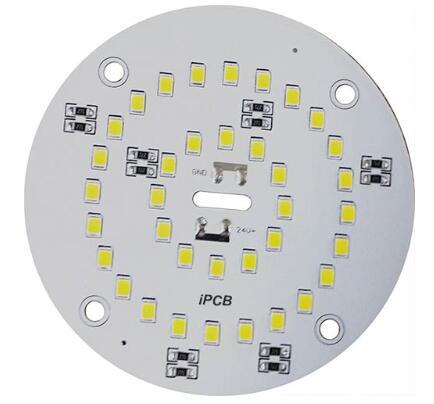Alumina substrate PCB is a metal-based copper-clad plate with good heat dissipation function. Generally, a single panel consists of a three-layer structure, namely a circuit layer (copper foil), an insulation layer, and a metal substrate. Commonly found in LED lighting products. There are two sides, one is for welding LED pins on the white side, and the other is in aluminum color. Generally, it will come into contact with the thermal conductive part after applying the thermal conductive paste.

Aluminum oxide ceramic is a ceramic material mainly composed of aluminum oxide (Al2O3), used in thick film integrated circuits. Alumina ceramics have good conductivity, mechanical strength, and high-temperature resistance. It should be noted that ultrasonic cleaning is required. Alumina ceramics are widely used ceramics, and due to their superior performance, their applications in modern society have become increasingly widespread, meeting the needs of daily use and special performance.
Working principle of alumina substrate PCB
The surface of power devices is mounted on the circuit layer, and the heat generated during device operation is quickly transmitted to the metal substrate through the insulation layer, which then transfers the heat out to achieve heat dissipation of the device.
Characteristics of alumina substrate PCB
The alumina substrate PCB is a low alloyed Al Mg Si series high plastic alloy plate, which has good thermal conductivity, electrical insulation performance, and mechanical processing performance. Compared with the traditional FR-4, the alumina substrate PCB uses the same thickness and line width and can withstand higher currents. The alumina substrate PCB can withstand up to 4500V, with a thermal conductivity greater than 2.0, and is mainly used in the industry.
1) Adopting surface mount technology (SMT).
2) Effective treatment of thermal diffusion in circuit design schemes.
3) Reduce product operating temperature, improve product power density and reliability, and extend product service life.
4) Reduce product volume, reduce hardware and assembly costs.
5) Replace the fragile ceramic substrate to obtain better mechanical Endurance.
Composition of alumina substrate PCB
1. Line layer
The circuit layer (usually made of electrolytic copper foil) is etched to form a printed circuit for the assembly and connection of devices. Compared to the traditional FR-4, with the same thickness and line width, the alumina substrate PCB can carry higher currents.
2. Insulation layer
The insulation layer is the core technology of alumina substrate PCB, mainly playing the functions of bonding, insulation, and thermal conductivity. The alumina substrate PCB insulation layer is the largest thermal barrier in the power module structure. The better the thermal conductivity of the insulation layer, the more conducive it is to the diffusion of heat generated during device operation, and the more conducive it is to reducing the operating temperature of the device, thereby increasing the power load of the module, reducing volume, extending lifespan, and improving power output.
3. Metal substrate
The metal used for insulating the metal substrate depends on the comprehensive consideration of the thermal expansion coefficient, thermal conductivity, strength, hardness, weight, Surface states and cost of the metal substrate.
Alumina substrate PCBs can be divided into: tin sprayed alumina substrate PCBs, anti alumina substrates, silver plated aluminum substrates, gold plated aluminum substrates, etc. according to the process; According to their usage, they can be divided into: street lamp aluminum substrate, fluorescent lamp aluminum substrate, LB aluminum substrate, COB aluminum substrate, packaging aluminum substrate, bulb lamp aluminum substrate, power supply aluminum substrate, automotive aluminum substrate, and so on.
Alumina substrate PCB can be reduced to the minimum thermal resistance value, resulting in good thermal conductivity. Compared with thick film ceramic circuits, their mechanical properties are also very excellent. Effectively address the heat dissipation issues in the circuit design scheme to reduce module operating temperature, extend service life, and improve power density and reliability.